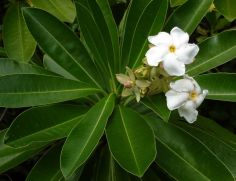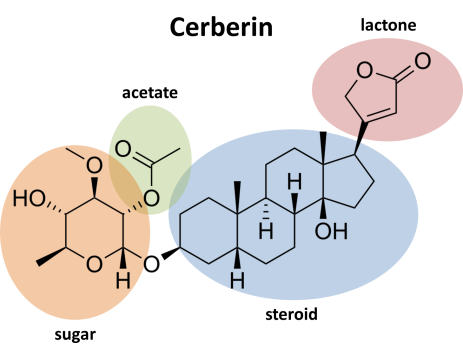My faithful readers are aware of my desire for things to be named as they are. It avoids confusion, and life is too short to be dazed and confused. So when I read about Cerbera odollam, the “Suicide Tree,” I get a warm, tingly feeling. Not because I’m some sort of sociopath, well, maybe just a little, but because I know exactly what to expect.
Cerbera odollam, is a tree that grows in the swamp and marshy areas of India and southern Asia. Going by the common name “Pong-pong” and growing upwards of 30 feet (~10 meters) tall, it has fruit that looks like a small, green, mango that covers an oval shaped kernel – which is just the seed inside the nut or pit of fruiting plants. Cerbera closely resembles Oleander, which you will remember is kind of a dick, with long, thick, green leaves and five-lobed flowers. So if I told you that both Oleander and Cerbera belong to the same family Apocynaceae, you wouldn’t be surprised. And if you’re clever, which all my readers are, you don’t need me to tell you that their toxicities are similar, too.
The Cerbera kernel contains several glycosides, with the most notable being cerberin. Take a look at the structure of cerberin, then take a look at the structure of oleandrin, from Oleander. There’s no hurry, I’ll wait. Do they look similar? Damned near identical, huh? Both have a steroid nucleus with a lactone moiety, and conjugated to a sugar, with the only difference being the position of the acetate group. So no surprise when I tell you that the toxic effects of cerberin mirror those of oleandrin.
Like oleandrin, cerberin binds to and inhibits cellular Na/K-ATPase – the so-called “sodium/potassium pump.” This pump transports sodium out of the cell, and potassium into the cell, necessary for action potentials in exciting nerves and muscles. When deactivated, sodium accumulates inside the cell, which then leads to an increase of intracellular calcium and extracellular potassium. The increase of calcium leads to an increase in heart contractility (inotropy) (1, for a review). In healthy people, this is a bad thing, as the heart is contracting much harder than it needs to, which could lead to an arrhythmia. And the increase in potassium? The medical term for that is hyperkalemia, and is actually induced in rare instances by the injection of potassium chloride…in lethal injections. Yeah, this is what actually kills people when death sentences are carried out by lethal injection in the United States, so you know hyperkalemia can be a bad thing. And in addition to all the cardiac effects, cerberin also induces nasuea and vomitting. Wonderful.
So how much is bad for you, that’s always the question, as the dose makes the poison – as every toxicologist likes to say. When it comes to the kernel of Cerbera odollam, just one is all it takes, particularly in areas with poor supportive care.

Cerbera odollam by Aneo (CC BY 2.0)
The moniker “Suicide Tree” is well earned. In a ten-year study in the Kerala state of India, Cerbera odollam was responsible for 537 poisonings, half of all plant poisoning cases (2). The most popular use though is suicide, most likely because it is widely available and its lethality well know. In these cases the individuals remove the kernel from the fibrous seed husk and mash it with cane sugar, making a sweet, albeit deadly, treat.
But we also can’t discount the use in homicides, where a few kernels are mixed in with spicy and flavorful foods to mask any bitterness. How often is Cerbera used in homicides? That’s hard to say, as cerberin would be difficult to detect in most well equipped forensics laboratories. And the under-equipped ones? Well-nigh impossible.
In the United States, without Cerbera odollam growing natively, there aren’t too many cerberin toxicity cases. But we do have the internet, and the ability to order damned near anything online, and that is precisely what one 51-year old Maryland woman did. With a history of depresion and prior suicide attempts, she purchased several seeds online and ingested them (3). She presented to the ED with complaints of naseau, vommiting, and chest tightness. Her initial heart rate was 30 beats per minute (bpm) with a blood pressure of 90/60 mm Hg. Her serum potassium and calcium levels were high, 7.5 mmol/L and 10.9 mg/dL, respectively. The medical toxicologists were on their game, as they suspected digoxin poisoning, but none was detected by their labs. It wasn’t until she admitted to ingesting seeds from a Pong-pong tree, and with an assist from poison control, that they administered digoxin immune FAB*.
*Digoxin immune fab (Digibind) is an antidote for digoxin (a cure for the broken hearted) or digitalis poisoning, and is made from the immunoglobulin fragments of sheep that have been innoculated with a digoxin derivative. Things that sound complicated are usually expensive, and this is no exception. The cost per vial that I have seen ranges from $500-700 (US). Yikes! The good news is that Digibind cross-reacts (works) with a wide range of cardiac glycosides – like oleandrin, digoxin, and cerberin.
All told she received twenty vials of the expensive treatment, but with great results, and she was later discharged in physically stable condition. Score one for the medical toxicologists.
In suicides and homicides people use what is available to them, which is why even in the United States we see such drastic regional differences. But this is also a reminder that while not all of Nature’s poisons are available to us next door, they are certainly accessible world wide…via the World Wide Web, that is. Times are changing, and it’s keeping all toxicologist on their toes.
For another source of cerberin toxicity, check out the Coconut Crab…yes, crab, here.
*** Homepage featured image of Cerbera odollam by Tau’olunga (CC BY-SA 3.0) ***
References:
1. Prassas, Ioannis, and Eleftherios P. Diamandis. “Novel Therapeutic Applications of Cardiac Glycosides.” Nature Reviews Drug Discovery 7.11 (2008): 926-35.
2. Gaillard, Yvan, Ananthasankaran Krishnamoorthy, and Fabien Bevalot. “Cerbera Odollam: A ‘suicide Tree’ and Cause of Death in the State of Kerala, India.” Journal of Ethnopharmacology 95.2-3 (2004): 123-26.
3. Kassop, David, Michael S. Donovan, Brian M. Cohee, Donovan L. Mabe, Erich F. Wedam, and John E. Atwood. “An Unusual Case of Cardiac Glycoside Toxicity.” International Journal of Cardiology 170.3 (2014): 434-37.


Ok, that woman’s suicide attempt costed the US more than $10K. Would it be cheaper to send her to psychological counseling? I guess yes.
Well, we don’t have a socialized (or publicly funded healthcare) system in the U.S., so I’m not sure if she, her insurance, or the hospital if uninsured, picks up the tab. But I do hope she received additional help and support.
One thing I don’t know is how readily available Digibind is to hospitals in “less affluent” areas where Cerbera grows natively. My guess is it’s not, sadly.
Thanks for reading!
Not if she is dead. Read it again it help save her life. Psychological counseling won’t save her life.
Is the sugar moiety hydrolyzed by stomach acid or intestinal microbial enzymes? If so, is the aglycone the true toxin?
…I seem to recall once hearing that digitoxigenin is markedly more toxic than digitoxin itself — but I can’t recall the source. If this is true for digitoxin, I wonder if it is true across the entire class of cardiac glycosides. (Which would then be, in retrospect, poorly named.)
That’s an awesome question!
I know the aglycones all have central activity, so that’s true, and metabolites are also cardioactive. But I wouldn’t necessarily say that it is primarily the aglycone that is the toxin.
Digoxin (from foxglove) is only mildly biotransformed in humans. About 95% of excreted digoxin in urine is unchanged, with only about 0.3% being digoxigenin. If digoxigenin were the primary agent, I would expect the concentrations to be much larger. Hope that helps a bit.
Thanks for reading!
That being the case, I agree completely — it’s unlikely that digitoxigenin is “the real killer.”
Thanks for writing, man! Very cool blog. 🙂
I don’t know if you will find it entertaining, but your post made me recollect about my early encounter with cardioglycosides
Anything I can do to contribute to Org Prep Daily is an honor.
That’s hilarious. Have you had any contact with the professor since then? I wonder what his side of the story is.
He was not a professor – just a clever toxic steroid chemist trying everything to get ahead. (“I can put you on my paper if you do the same for me”). I run into him years later when I applied to the institute grad school program. Also, I was no good in any way, and he already had one very slick young boy working for him at the time – who since then became a faculty at Columbia and is famous for some retracted papers…
Whoah!! Six degrees of separation going on here. That scandal was all sorts of fun for the chemistry blogosphere.
Pingback: Cerberin: Death by Coconut Crab | Nature's Poisons
Pingback: Toxic Larvae: Arrow Poison from the Bushmen of the Kalahari | Nature's Poisons
Pingback: The Murder Tree
Pingback: The very first Botanical University Challenge -10/3 at RBG Kew! | Dr M Goes Wild
Pingback: $5 suicide: A look at the deadly Pong-pong seed. | DailyHaze
How long would one need to get to the hospital before dying once ingested?
For an accidental ingestion, I’d say immediately (or as soon as humanly possible) so that the clinicians can get to work…and hopefully they have DigiFab.
Pingback: Antiarin and the Legend of the Upas Tree | Nature's Poisons
Interesting, i’m from the south of India, and have seen these trees quite a lot, had no idea they were so poisonous.
una persona che conosco dice di averne ingerito un quantitativo minimo, neanche mezzo seme, e ha riferito di aver vomitato per una notte intera e dormito per quasi tutto il giorno successivo. Non è andata in ospedale, è rimasta a casa sua e dopo circa due giorni si è ripresa bene. Ha avvertito un poco di freddo, tremore, mal di schiena e nausea, ma sembra essersi messa a posto da sola. Potranno succederle altre ricadute dannose oppure probabilmente, dato tutto il vomito che ha emesso, la tossina è già stata completamente espulsa dal suo corpo prima che potesse agire?
Pingback: Chapter 48 Traveling Notes – MereBear's Translation
1
1*1
1*851*846*0
1+856-851-5
1*852*847*0
1+857-852-5
1*246*241*0
1+251-246-5
1*if(now()=sysdate(),sleep(15),0)
1′”
1����%2527%2522\’\”
@@RmIgg
1OtGEMeMG
1*866*861*0
1+871-866-5
1*247*242*0
1+252-247-5
1*715*710*0
1+720-715-5
1*346*341*0
1+351-346-5